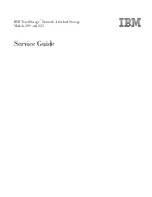
Configure the device using the ConnectPort LTS web interface
Configuration through the web interface
Digi ConnectPort LTS User Guide
43
n
Source Based Routing
: Choose this option to if you have two routers (gateways) in your
network and you want each interface to use a different router. For example, if you enable this
option, any traffic that originates from the IP address of Ethernet interface 2 (replies to traffic
that came in Ethernet interface 2), will be routed back out through the same Ethernet
interface 2. Please note that this option applies only to Ethernet interface 1 and 2 by default.
l
Enable Local Routing
: Select this option to enable local routing.
n
Network Bonding
: Use the link aggregation feature to aggregate one or more Ethernet
interfaces to form a logical point-to-point link, known as a LAG (link aggregation groups), virtual
link, or bundle. The MAC client can treat this virtual link like a single link. Network Bonding
implements 802.3ad.
l
Do not use this interface
: Choose this option if you do not want to enable network
bonding on this Ethernet interface.
l
Obtain an IP address automatically using DHCP
: Choose this option if you want to
obtain new network settings after you reboot the ConnectPort LTS device.
l
Use the following IP address
: Choose this option to manually enter static IP address
settings.
l
Subnet Mask
: The subnet mask for the ConnectPort LTS device. A common subnet mask is
255.255.255.0.
l
Gateway
: The IP address of the computer that enables the ConnectPort LTS device to
access other networks, such as the Internet.
Basic Network Services Settings
The Basic Network Services Settings page shows a set of common network services that are available
for ConnectPort LTS products, and the network port on which the service is running.
You can enable and disable common network services and configure the TCP/UDP port on which the
network service listens. You can disable services as needed for security purposes. That is, you can
disable certain services so the device runs only those services specifically needed. To improve device
security, you can disable non-secure services such as telnet.
Best practice
Use the default network port numbers for basic network services because the port
numbers are used by most applications.
CAUTION!
Exercise caution when enabling and disabling network services, particularly
disabling them. Changing certain settings can render a Digi Connect device inaccessible.
For example, disabling Advanced Digi Discovery Protocol (ADDP) prevents a network
from discovering the device, even if it is actually connected. Disabling HTTP and HTTPS
disables access to the web interface. Disabling basic services such as telnet, rlogin, and
so on makes the Command-Line interface inaccessible.
Supported basic network services and their default port numbers
For Digi devices with multiple serial ports, the network port number defaults for various services are
set based on the following formula:
base network port serial port number
















































